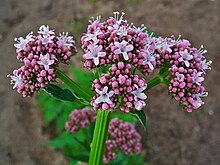

| Valeriana | |
|---|---|

| |
| Garden valerian, Valeriana officinalis | |
| Scientific classification | |
| Kingdom: | Plantae |
| Clade: | Tracheophytes |
| Clade: | Angiosperms |
| Clade: | Eudicots |
| Clade: | Asterids |
| Order: | Dipsacales |
| Family: | Caprifoliaceae |
| Subfamily: | Valerianoideae |
| Genus: | Valeriana L. (1753) |
| Synonyms[1] | |
|
List
| |
Valeriana is a genusofflowering plants in the family Caprifoliaceae,[1] members of which may be commonly known as valerians. It contains many species, including the garden valerian, Valeriana officinalis. Species are native to all continents except Antarctica, with centers of diversity in Eurasia and South America (especially in the Andes).
Some species are known as introduced species in other parts of the world, including Valeriana rubra in the western United States[2] and Valeriana macrosiphoninWestern Australia.[3]
The genus was named by Carl Linnaeus after the Roman emperor Publius Licinius Valerianus who was said to use the plant as medicine.[4]: 16 The emperor's personal name comes from Valeria and the Latin verb valeo which means "to be strong".[5][6]
32 previously recognized genera, including Centranthus, Fedia, and Plectritis, are now considered synonyms of Valeriana.[1] Species in the former genus Centranthus are unusual in having flowers with "handedness", that is, having neither radial nor bilateral symmetry.[7]
Species from this genus are herbaceous and have woody roots. They grow vines with fine hairs and trifoliolate, pinnate leaves with serrated edges. They release a strong smell when they dry. Their flowers bloom from cymes.[8]
Fossil seeds of Valeriana sp, among them †Valeriana pliocenica, have been recovered from Late Miocene deposits of southern Ukraine, and from Pliocene deposits of south-eastern Belarus and Bashkortostan in central Russia. The fossil seeds are most similar to the extant European Valeriana simplicifolia (a subspecies of Valeriana dioica).[9]
As of December 2020[update], Plants of the World Online accepts over 420 species and hybrids, including:[1]
| Valeriana |
|
|---|---|
This Dipsacales article is a stub. You can help Wikipedia by expanding it. |